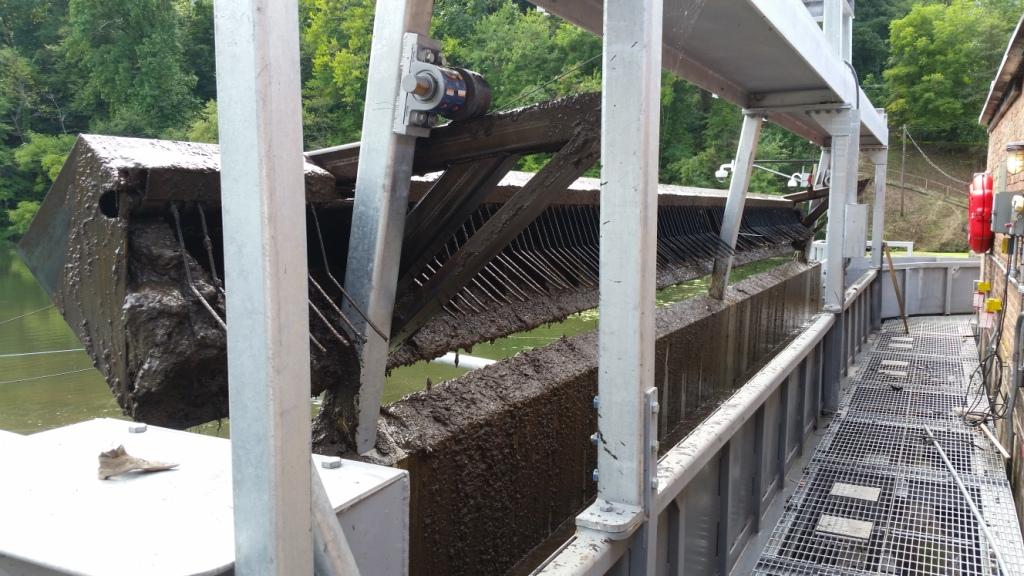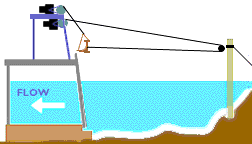The Dragrake


The Dragrake is an extremely effective and durable intake cleaning
system with a unique approach to handling trash. Compared with other
systems the Dragrake has greater raking width, unparalleled speed and
strength, as well as the ability to dredge the canal floor upstream of
the intake.
Most systems rake only a narrow swath, operate very slowly and
require an operator. These systems are no match for large, water-soaked
logs and few are able to remove any material build-up in front of the
rack area. Rolling carriage type rakes have a tendency to pack trash to
the bottom and cannot remove silt and debris which collect upstream of
the rack face. Backhoe type machines are greatly limited in strength and
raking width. The Dragrake does an excellent job of removing all types
of trash from the rack itself but more importantly, it dredges the canal
floor upstream of the rack face for whatever distance is required.
The Dragrake is available up to 45 feet wide and can clean and dredge
a 60 foot deep intake in 2 minutes. For intakes over 45 feet in width,
multiple Dragrakes are installed. This allows thousands of square feet
of intake to be cleaned in minutes, automatically!
 At
sites where siltation is a problem the Dragrake's performance is
superior to other cleaning systems. At one site previous to installation
of a Dragrake, the plant required an annual shut-down for silt removal
costing the owner valuable run time as well as the cost of excavation.
Since installation of our system over eight years ago, the Dragrake has
prevented silt from accumulating in front of this intake. In addition,
it has prevented silt from traveling further down the canal to other
intakes. No shutdowns have been required for silt removal. In addition
this site has seen increased production and decreased labor cost. At
sites where siltation is a problem the Dragrake's performance is
superior to other cleaning systems. At one site previous to installation
of a Dragrake, the plant required an annual shut-down for silt removal
costing the owner valuable run time as well as the cost of excavation.
Since installation of our system over eight years ago, the Dragrake has
prevented silt from accumulating in front of this intake. In addition,
it has prevented silt from traveling further down the canal to other
intakes. No shutdowns have been required for silt removal. In addition
this site has seen increased production and decreased labor cost.
Operation
The Dragrake operates by a system of motorized cable hoists
which move a raking beam in a cyclical motion. This cycle begins
with the raking beam at the trash dumping position located at the
top of the trash rack. The raking beam is hoisted upstream and
lowered into the water to the bottom of the intake several feet
upstream from the toe of the trash rack. The raking beam now
dredges the bottom of the intake until it reaches the bottom of
the trash rack whereupon it rakes up the rack face bringing its
trash load to the dumping position. This action allows the
Dragrake to dredge debris which accumulates upstream, impeding
flow and limiting production.
The raking beam has a replaceable leading edge, flushing
windows to allow silt and very small debris to pass through the
trash rack and spring-loaded tines to remove impacted debris from
in between the trash rack bars. Adjustable attachment chains allow
for changes in the raking beam's angle to accentuate either its
dredging or raking action. All components are accessible from
above water level eliminating equipment failure which would
require dewatering or diving for repair.
The Dragrake can capture and lift thousands of pounds of trash
each cycle, cleaning the entire trash rack area. Systems in
operation have proven themselves by raking logs twenty-six inches
in diameter by twenty-five feet long weighing well over two
thousand pounds.
The Dragrake system operates automatically by a programmable
logic controller or manually by a joystick control handle. Five
selectable cycle time delays are provided for varying trash
conditions. Rack differential sensing is available. Each winch
motor has its own power monitoring relay to prevent overload or
possible damage in the event of the rake beam hanging up.
|
|